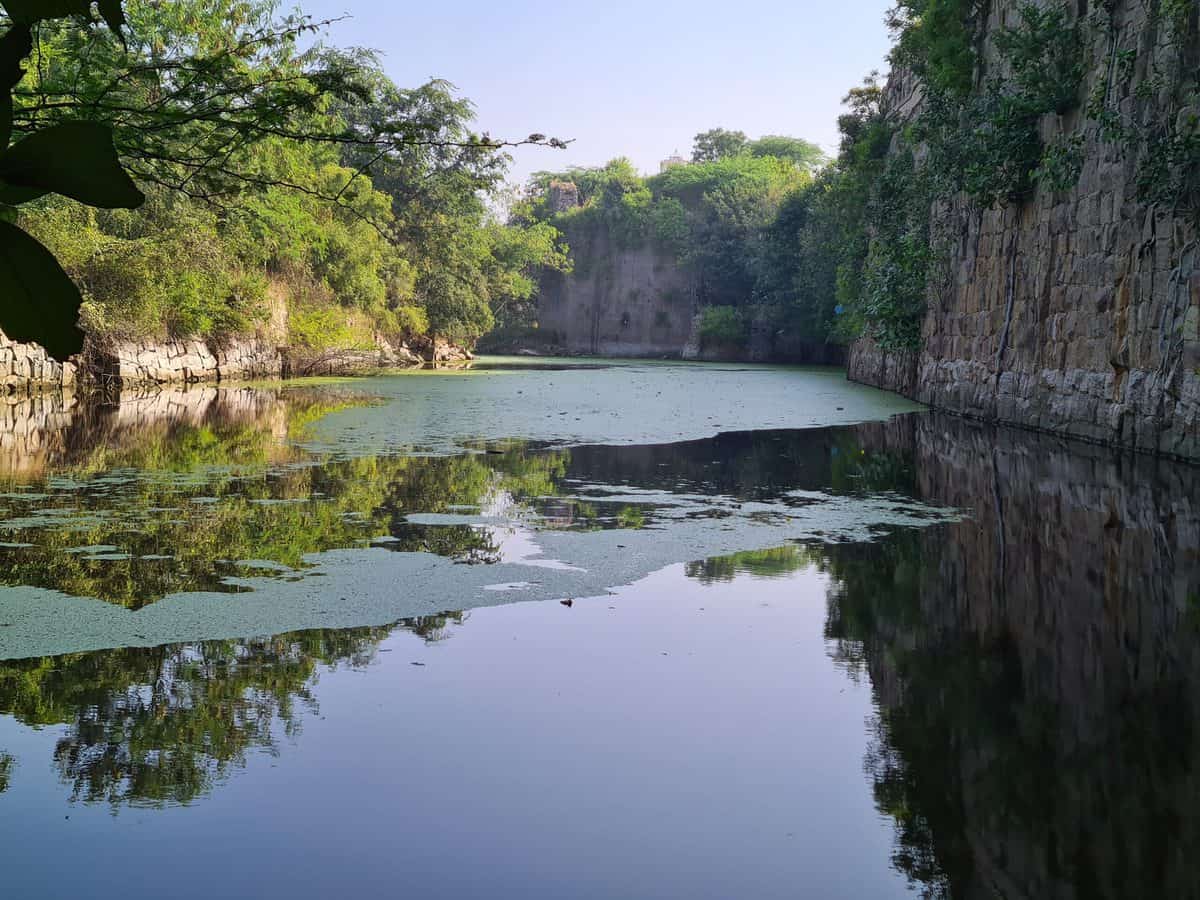Hyderabad: Owing to heavy rains last month, about a handful of heritage structures in the city had been damaged at different places. Two of those were in the ancient Golconda fort area itself. While a bastion had collapsed in the Naya Qila area of the fort, another wall of the inner citadel had collapsed too. Both incidents have been met with severe criticism from citizens.
While the Golconda fort has been encroached upon and damaged at several places over past decades, one of its neglected gates however has escaped notice and has been lying in ruins from years. The Patancheru Darwaza, which is among the fort’s eight gates, and is located near the Katora Houz lake on the way to the main entrance, has been left to its fate by authorities.
Interestingly, the Darwaza’s moat, due to the heavy rains in October, has actually filled up and has turned into a green area of sorts. Usually, there is very minimal water in it. The moat, along with the rest of the Golconda fort, is a remnant of the place which was a walled-city until Hyderabad was founded later in 1591 by the Qutb Shahi kings.
Unlike at other gates , where the moats have been fully filled up with mud and roads have been built over them, the Patancheru Darwaza is perhaps the last remnant of the fortification, as to how it may have been during the Qutb Shahi or Golconda period (1518-1687).
The Patancheru Darwaza, apart from still having intact bastions, also has strikingly beautiful carvings on its walls. Interestingly, these designs are elements that one can find in Hampi, the capital of the Vijayanagar empire, which was a contemporary of the Qutb Shahi dynasty and also to other Deccan sultanates. Its entrance has also unfortunately been turned into a garbage dump by locals.

In October, the Majnu bastion inside the Naya Qila had also collapsed due to heavy rains. The bastion was already in a vulnerable state since September, and wedge marks on the rock show some human intervention with regard to the collapse.
While it is yet to be ascertained as to how a solid piece of rock came crashing down, activists suspect that some work which had been taken up by the Hyderabad Golf Course Association (HGA), which runs a golf course in the historic Naya Qila area, and also the Greater Hyderabad Municipal Corporation (GHMC), may have caused the damage.
No security or upkeep at Patancheru Darwazza
When contacted, a senior official from the Archaeological Survey of India (ASI), who requested anonymity, confirmed that the Patancheru Darwaza does fall under the ASI’s purview. On enquiring about security there, he informed that there is no constant monitoring there.
“Our personnel go there once in a while to check up on the place, and even the army, under which parts of it fall under, monitors the place. We have also given the proposal to repair the Majnu bastion at Naya Qila and will undertake works once it is cleared,” he told siasat.com.

History of the Golconda fort
The Golconda Fort’s origins are traced back to the 14th century when the Rajah of Warangal Deo Rai (under the Kakatiya Kingdom which ruled from Warangal) built a mud fort. It was taken over by the Bahmani Empire between 1358 and 1375. Later, it was developed into a full-fledged citadel by Sultan Quli who founded the Qutb Shahi kingdom in 1518 following the death of last sovereign of Bahmani Emperor Mahmud Shah.
Sultan Quli was a commander and later governor of Tilang (Telangana), under the Bahmani Empire (1347-1518), when its second capital was at Bidar. Sultan Quli, who was originally from Hamadan, rose to the level of Governor under the Bahmani Empire. At this point of time he was given the fort, around which he began developing a walled-city.
It eventually came to be called Golconda Fort (name derived from Telugu Golla-conda, or shepherds hill). It existed as a walled-city until Hyderabad was founded in 1591 by Sultan Quli’s grandson Mohd. Qili Qutb Shah.
The fort has 87 bastions, and eight gates, of which a few are not accessible to the general public as they are under the army control. It is believed to be one of the Deccan’s most impregnable forts, and had kept Mughal emperor Aurangzeb’s army at bay for eight months until he succeeded and conquered Hyderabad in 1687.

